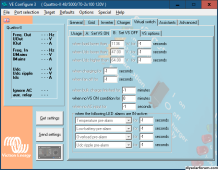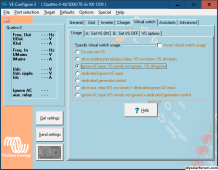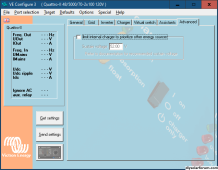I finally started to play with the Victron toys I bought from you almost a year ago.
This epic delay is due to the solar companies which are struggling to understand what a Victron ESS system is.
It's basically a DC coupled solar ESS system, no feed into the grid.
I have a Lynx power in, shunt a and two distrubutors.
Three Smart Solar RS and two Quattro inverters for generating the 120VAC split phase.
To get everything up and running I am orienting myself on this guide
https://www.victronenergy.com/live/ess:start
However I would like to have your opinion on a couple of topics.
This is what I would like to achieve
1) Lynx Shunt
it provides Vbatt and batt SOC to the system.
Here I tend to ignore the SOC (since it could drift over time) and get the batteries charge state based on the DC Vbatt.
I could also setup a temp sensors but as a first implementation let's keep it simple, I don't wanna use it for now.
Please advice is I should use the SOC from the shunt or not.
2) Two Quattro Inverterts 10000 to generate the 120VAC split phase for the home
Setup
Vbat > 51.2V [SOC > 20%] Inverting, no power pulled from grid.
Vbat <50V [SOC < 10%] Battery charged from the grid (if possible) to prevent a severe empty battery state
between the above Passthrough, power pulled from the grid
Do you think it is possible to use the power assist function in the inverting state to get power from the grid if the home is demanding more than the inverter can deliver from the batteries?
Example:
Home is demanding 12KW from each 120VAC phase, 24KW total.
The two Quattros can deliver only 8KW each, 16KW total of max inverting power (ignore startup...).
The missing 24-16=8KW (4KW each phase) will be automagically pulled from the grid to make the home happy.
3) Three Smart Solar MPPT RS 450|100
They will be in sync with the same parameters.
Setup
Vbat > 53.2V [SOC > 80%] Floating, no energy flow from solar panels to the 48VDC bus
Vbat < 53.2V [SOC < 80%] Bulk charging, all the solar energy available will be delivered to the 48VDC bus
Do you think it is necessary to setup an ESS assistant to achieve the above?
I would very appreciate if you could push me into the right direction.
Many thanks in advance,
Should I post it in the Victron forum?
This epic delay is due to the solar companies which are struggling to understand what a Victron ESS system is.
It's basically a DC coupled solar ESS system, no feed into the grid.
I have a Lynx power in, shunt a and two distrubutors.
Three Smart Solar RS and two Quattro inverters for generating the 120VAC split phase.
To get everything up and running I am orienting myself on this guide
https://www.victronenergy.com/live/ess:start
However I would like to have your opinion on a couple of topics.
This is what I would like to achieve
1) Lynx Shunt
it provides Vbatt and batt SOC to the system.
Here I tend to ignore the SOC (since it could drift over time) and get the batteries charge state based on the DC Vbatt.
I could also setup a temp sensors but as a first implementation let's keep it simple, I don't wanna use it for now.
Please advice is I should use the SOC from the shunt or not.
2) Two Quattro Inverterts 10000 to generate the 120VAC split phase for the home
Setup
Vbat > 51.2V [SOC > 20%] Inverting, no power pulled from grid.
Vbat <50V [SOC < 10%] Battery charged from the grid (if possible) to prevent a severe empty battery state
between the above Passthrough, power pulled from the grid
Do you think it is possible to use the power assist function in the inverting state to get power from the grid if the home is demanding more than the inverter can deliver from the batteries?
Example:
Home is demanding 12KW from each 120VAC phase, 24KW total.
The two Quattros can deliver only 8KW each, 16KW total of max inverting power (ignore startup...).
The missing 24-16=8KW (4KW each phase) will be automagically pulled from the grid to make the home happy.
3) Three Smart Solar MPPT RS 450|100
They will be in sync with the same parameters.
Setup
Vbat > 53.2V [SOC > 80%] Floating, no energy flow from solar panels to the 48VDC bus
Vbat < 53.2V [SOC < 80%] Bulk charging, all the solar energy available will be delivered to the 48VDC bus
Do you think it is necessary to setup an ESS assistant to achieve the above?
I would very appreciate if you could push me into the right direction.
Many thanks in advance,
Should I post it in the Victron forum?






